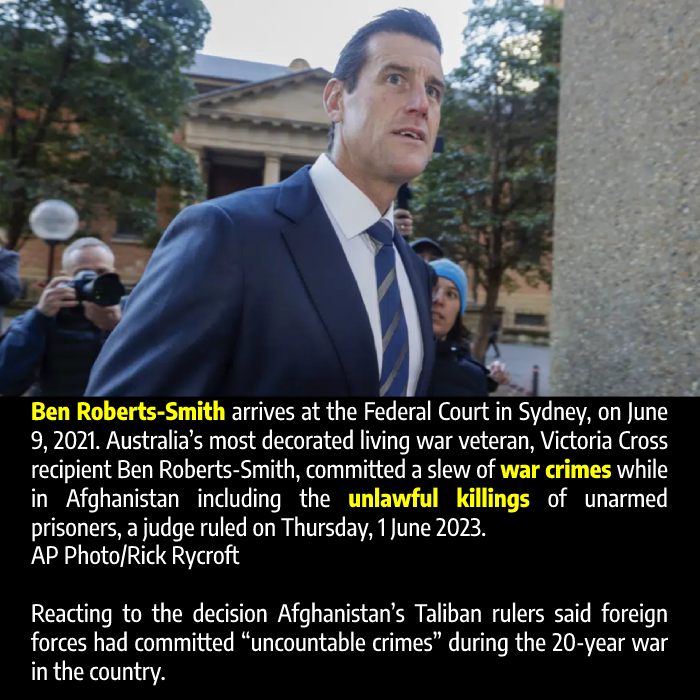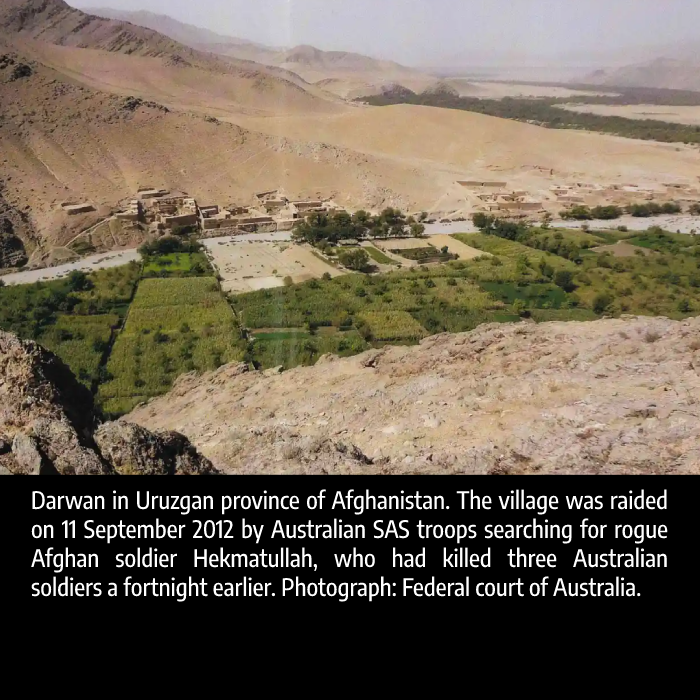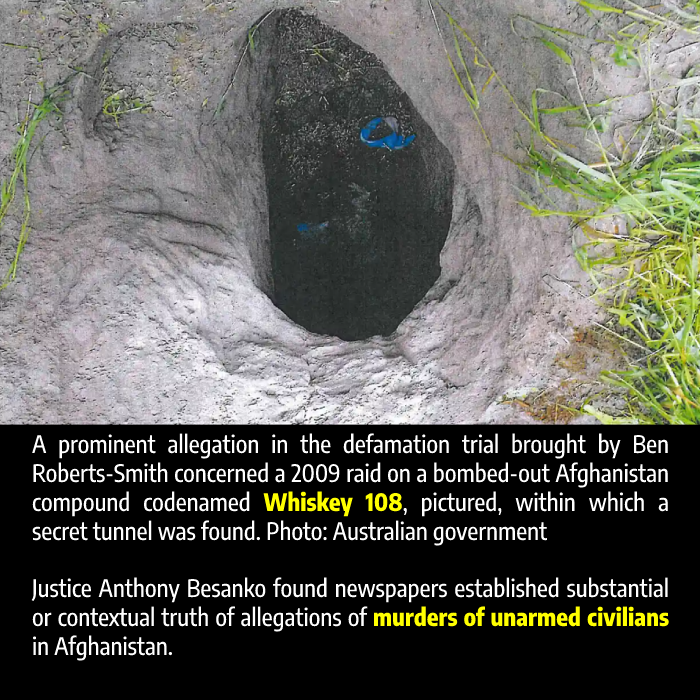By Ben Doherty in Sydney.

Ben Roberts-Smith VC, Australia’s most decorated living soldier, murdered unarmed civilians while serving in the military in Afghanistan, a federal court judge has found.
Sitting in Sydney, Justice Anthony Besanko found that on the balance of probabilities, Roberts-Smith kicked a handcuffed prisoner off a cliff in Darwan in 2012 before ordering a subordinate Australian soldier to shoot the injured man dead.
And in 2009, Roberts-Smith ordered the killing of an elderly man found hiding in a tunnel in a bombed-out compound codenamed “Whiskey 108”, as well as murdering a disabled man with a prosthetic leg during the same mission, using a para machine gun.
The judgment, which came after a mammoth year-long defamation trial, is not a criminal finding of guilt, but a determination on the civil standard of the “balance of probabilities”.
A summary of the judgment has been published by the federal court. The full reasons will be published on Monday afternoon, after the commonwealth has checked the judgment for national security concerns.
Lawyers for the three newspapers – the Age, the Sydney Morning Herald and the Canberra Times – who were sued by Roberts-Smith, have asked for several weeks to determine applications around costs of the trial.
The civil judgment is likely to see Roberts-Smith liable to pay millions of dollars in costs to the newspapers. The cost of the trial is estimated to be upwards of $35m (£18.3m).
The former SAS corporal had taken out a loan, believed to be $2m, from his employer, Channel Seven owner Kerry Stokes, to fund his defamation case. He appears now almost certain to lose his Victoria Cross medal that he surrendered as collateral.
An appeal by Roberts-Smith to the full bench of the federal court appears likely.
The former soldier was not in the courtroom in Sydney for the judgment. He is currently on the resort island of Bali, Indonesia, with some media publishing screengrabs of him on a sun lounger. He was not under any obligation to attend the hearing.
The judge found it proved that Roberts-Smith was a “criminal” who “broke the moral and legal rules of military engagement” over an incident at Chenartu in 2012, which resulted in the execution of an Afghan man who was being held prisoner.
In his summary Besanko ruled that allegations Roberts-Smith was complicit in further murders in Syahchow and Fasil, all in southern Afghanistan in 2012, were not proven.
But the judge found the newspapers had proven that Roberts-Smith bullied and assaulted his comrades.
Besanko ruled the newspapers however had failed to prove their allegation that Roberts-Smith committed an act of domestic violence in 2018 against a woman with whom he was having an affair. Nevertheless the newspapers succeeded on a contextual truth defence and their publication of the allegation did not defame him.

Roberts-Smith is Australia’s most decorated living soldier and the recipient of the Victoria Cross for “most conspicuous gallantry” during the battle of Tizak in 2010.
He had enjoyed a stellar public reputation, lionised as the exemplar of Australia’s ultimately unsuccessful mission to bring peace and prosperity to Afghanistan, held up as the modern embodiment of Australia’s Anzac legend. The most famous soldier of his generation, Roberts-Smith was also named Father of the Year and served as chair of the government’s Australia Day Council.
But in 2018, the Age, the Sydney Morning Herald and the Canberra Times published a series of articles that alleged he engaged in war crimes, including murdering civilians and ordering subordinate soldiers under his command to kill civilians in so-called “blooding” incidents.
Roberts-Smith sued the newspapers, telling the court their stories portrayed him as a criminal “who broke the moral and legal rules of military engagement” and “disgraced” his country and its army.
The newspapers defended their reporting as true.
The trial heard more than 100 days of evidence over more than a year, including extraordinary testimony of killing performed by Australian soldiers, and of a spiteful, factionalised SAS regiment, deeply riven by internecine fighting over decorations and medals and in thrall, on some evidence, to a “warrior culture” steeped in violence.
Dramatically, three SAS soldiers accused of murder on separate missions refused in court to answer questions about what they did in Afghanistan, objecting on the grounds that any truthful answer they gave would be self-incriminatory. Each was permitted by Besanko not to answer.
The most high-profile allegation proved in court was that Roberts-Smith, on a mission to the southern Afghan village of Darwan in 2012, marched a handcuffed man named Ali Jan to the edge of a 10-metre precipice that dropped down to a dry river bed below.
Roberts-Smith then kicked Ali Jan in the chest, sending him falling backwards over the cliff, his face hitting the cliff as he fell, before he landed on the ground below.

Ali Jan survived the fall, though he was badly injured, and was trying to get to his feet when the Australian soldiers, having walked down a diagonal footpath cut across the cliff, reached him.
Roberts-Smith ordered a soldier under his command, known before the court as Person 11, to shoot Ali Jan dead, an order that was followed. Ali Jan’s body was then dragged to a nearby field.
The other major allegation concerned a raid on a bombed-out compound code-named Whiskey 108 in 2009.
Two men were found hiding in a tunnel: one, an elderly man, the other a younger man with a prosthetic leg. The men came out of the tunnel unarmed and surrendered.
Besanko found that Roberts-Smith ordered a junior soldier on his patrol to shoot the old man, before he forcibly manhandled the disabled man outside the walls of the compound where he threw him to the ground and fired his para machine gun into his prone body, killing him.
The disabled man’s leg was later souvenired by another soldier and used by Australian SAS troops as a macabre celebratory drinking vessel at their on-base bar, The Fat Ladies Arms.
The onus of proof in the defamation case rested with the newspapers, who were required to prove to the civil standard of “balance of probabilities” that the allegations they had published were true.
Nick McKenzie and Chris Masters, two of the journalists at the centre of the trial, spoke outside court on Thursday.
“Today is a day of justice,” McKenzie said. “None of the SAS witnesses wanted to go to court. Ben Roberts-Smith brought this case, he came almost every day. But he did not come today. He’s in Bali, doing whatever he’s doing.”
Masters thanked the newspapers and their legal team. “It was a great call back in June 2018 to run this story. I think it will go down in the history of the news business as one of the great calls,” Masters said.
Robert-Smith’s barrister, Arthur Moses SC, said: “We’ll obviously consider the lengthy judgment that his honour has delivered and look at issues.”
Additional reporting by Elias Visontay.
Source: The Guardian. 2 June 2023